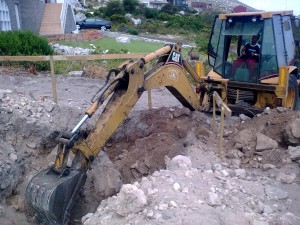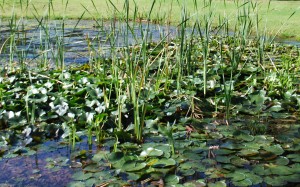CHAPTER < FIVE – GIFTS FROM GOD
“The overall pace of environmental change has unquestionably been accelerated by the recent expansion of the human population … The future of our planet is in the balance.” Joint statement by the U.S. National Academy of Sciences and the Royal Society of London
The changes that people are forcing on the global environment are not, unfortunately, limited to altering the atmosphere and weather patterns. At grave risk also is the fragile layer of soil on which our very lives depend.
 Since the Neolithic Revolution began between 10 000 and 12 000 years ago, when people first began to adopt farming as a way of life necessary to feed growing populations, the quality of soil and the amount of water that was available for irrigation were crucial to the success of harvests and the survival of communities. This equation has never changed. But contrary to what might be believed, farming was not an easy alternative to a hunter-gatherer way of life, as wresting crops from sometimes unwilling soil was uncertain and both time and labour-intensive.
Since the Neolithic Revolution began between 10 000 and 12 000 years ago, when people first began to adopt farming as a way of life necessary to feed growing populations, the quality of soil and the amount of water that was available for irrigation were crucial to the success of harvests and the survival of communities. This equation has never changed. But contrary to what might be believed, farming was not an easy alternative to a hunter-gatherer way of life, as wresting crops from sometimes unwilling soil was uncertain and both time and labour-intensive.
Early farmers suffered from a number of afflictions that were unknown to their hunter-gatherer predecessors. Among their tribulations were conditions such as malnutrition caused by failed crops and a limited number of foodstuffs in their diet. Hard manual labour in fields and long hours spent bent over the grindstone led to arthritis in both men and women. Changed living conditions and a high-starch diet resulted in disease, tooth decay and excessive tooth wear. The body growth of early farmers and their families was stunted and their life expectancy was reduced, and yet because of the pressure of growing populations on natural resources, agriculture and animal domestication eventually supplanted hunting and gathering all over the world.
 Since then humankind has been inordinately reliant on the thin layer of soil that plants grow in. It is the beginning of the food chain for us and every other living creature on the continents of the Earth. Yet since 1945, “11 per cent of the earth’s vegetated surface has been degraded – an area larger than India and China combined – and per capita food production in many parts of the world is decreasing” as warned by the Union of Concerned Scientists in their Warning to Humanity. In terms of actual topsoil, it is estimated that well over 20 per cent of the world’s topsoil has been lost from agricultural lands since 1950.
Since then humankind has been inordinately reliant on the thin layer of soil that plants grow in. It is the beginning of the food chain for us and every other living creature on the continents of the Earth. Yet since 1945, “11 per cent of the earth’s vegetated surface has been degraded – an area larger than India and China combined – and per capita food production in many parts of the world is decreasing” as warned by the Union of Concerned Scientists in their Warning to Humanity. In terms of actual topsoil, it is estimated that well over 20 per cent of the world’s topsoil has been lost from agricultural lands since 1950.
Earth Changing
Soil is formed by the extremely slow and complicated process of weathering rock together with the interrelationship of water, air and living organisms. It is effectively the product of decay but it is also the humus of life. For generation upon generation a handful of rich, dark soil has had momentous significance: with a plot of ground a family had the means of warding off starvation. Modern people, however, have become removed from the land and overly reliant on farmers and farming communities to supply their food. In the process many of us have forgotten the immense importance of this fragile layer and we have allowed destructive practices to harm the soil that has produced the food that has ensured our own and other species’ survival.
Many 20th Century farmers around the world treated their land with careless disrespect. At fault were outdated methods of farming and grazing as well as improper irrigation methods, which increased the salt level of the soil. Having once recycled farmyard manure and other organic nutrients to enrich their soil, farmers turned away from this age-old practice. In order to maintain or better their production quotas, synthetic chemical fertilisers were used, and in much of the Third World the Earth’s topsoil was rendered exhausted through constant overuse: unable to produce much except weak, nutrient-deficient plants.
 Through the cutting down of forests and the clearing of land, precious soil was exposed to the elements. The Sun then baked this life giving earth into dust or the hardness of brick. Unprotected by cool, shading foliage and unanchored by delicate root systems, this precious humus was carried away by wind and rain, eventually bleeding into the sea. Through the effects of blasting, quarrying, mining, burying of waste and the extraction of resources such as minerals, coal and oil, vast tracts of ground were rendered useless for years to come; scars on the Earth’s crust that could take millennia to heal. Earth changing on a similarly destructive scale has occurred through the activities of nuclear testing.
Through the cutting down of forests and the clearing of land, precious soil was exposed to the elements. The Sun then baked this life giving earth into dust or the hardness of brick. Unprotected by cool, shading foliage and unanchored by delicate root systems, this precious humus was carried away by wind and rain, eventually bleeding into the sea. Through the effects of blasting, quarrying, mining, burying of waste and the extraction of resources such as minerals, coal and oil, vast tracts of ground were rendered useless for years to come; scars on the Earth’s crust that could take millennia to heal. Earth changing on a similarly destructive scale has occurred through the activities of nuclear testing.
In the decades of the second half of the 20th Century, ocean atolls were literally vapourised off the face of the Earth by the utter destructiveness of nuclear blasts. Nuclear testing on land caused webs of radioactive tunnels and craters to form around test sites. It is feared that these deadly catacombs could collapse one day in massive subsidence, releasing buried radioactivity into the atmosphere.
Underground testing has caused the surrounding rock to melt, transforming it into a molten state before resolidifying it into a glass-like form which has entombed the radioactive products of the blasts. It has also caused a web of cracks to form in the rock, which has made the rock vulnerable to leakage. In addition to these earth-changing effects, underground nuclear testing has altered the location of strain fields in Nevada in the United States, as tectonic plate formations have been moved away from pre-test positions. This has triggered hundreds of earthquakes in the region.
 Other agents of earth changing on a destructive scale have been hydroelectric schemes. These massive artificial bodies of water pressing down on the tectonic plates of continents are believed to have influenced seismic patterns, also provoking earthquakes. The Konya Dam in India, the Hoover Dam on the Colorado River in the United States and the Kariba Dam in Zimbabwe are just such examples. Excavation and the pumping of oil and water from the earth have additionally affected geological and soil structures. In these ways neutral stresses have been reduced, altering the structural strength of rock, sand and clay, causing subsidence and landslides.
Other agents of earth changing on a destructive scale have been hydroelectric schemes. These massive artificial bodies of water pressing down on the tectonic plates of continents are believed to have influenced seismic patterns, also provoking earthquakes. The Konya Dam in India, the Hoover Dam on the Colorado River in the United States and the Kariba Dam in Zimbabwe are just such examples. Excavation and the pumping of oil and water from the earth have additionally affected geological and soil structures. In these ways neutral stresses have been reduced, altering the structural strength of rock, sand and clay, causing subsidence and landslides.
The earth that we haven’t minced and gouged and ripped, polluted and deformed, fried and bled away; we have smothered with concrete in a spread of cities and a network of highways. Eventually it is believed that the mega cities of the world could expand into an ecumenopolis: a gigantic city that covers the Earth’s land surface in a continuous urban sprawl stretching from horizon to horizon.
 Picture this possible world of the future in your mind’s eye. No more cool, leafy glades for forest creatures to hide in. No more wide, open grasslands rippling golden on a hot summer’s day. No more wetlands sparkling diamond-bright between green reeds. No more wild places to provide solace for soul-weary city dwellers. Just a gargantuan grey sprawl of buildings, factories, roads, highways, malls and parking lots stretching from north to south, east to west, further than the eye can see. What a tragedy for the Earth and all life on it, should this one-day come to pass.
Picture this possible world of the future in your mind’s eye. No more cool, leafy glades for forest creatures to hide in. No more wide, open grasslands rippling golden on a hot summer’s day. No more wetlands sparkling diamond-bright between green reeds. No more wild places to provide solace for soul-weary city dwellers. Just a gargantuan grey sprawl of buildings, factories, roads, highways, malls and parking lots stretching from north to south, east to west, further than the eye can see. What a tragedy for the Earth and all life on it, should this one-day come to pass.
Perhaps when the time comes that the damage we have inflicted on our planet catches up with us to the point of making Earth uninhabitable as a home, we will look beyond the boundaries of this planet to colonise other worlds. However we shouldn’t count on escape from our planet being possible in the near future. Because, before we are able to achieve the technical capability to terraform other asteroids and planets, in other words create an artificial environment in which to survive, we will first have to overcome the physical limitations and psychological implications of being Earthlings. For we were never meant to live in space. It is a dark, forbidding and alien environment for a species such as our own that has evolved with oxygen, sunlight, earth, water, foliage, sky, other living creatures and above all, gravity, as significant forms of reference.
Grounded as we are by Earth’s gravitational pull, long-duration space flights have been found to create changes in the muscles and bones of space workers: changes that research scientists are presently working hard to overcome. And until the transition from Earthlings to people able to live in outer space has been achieved, if indeed it ever will be, some of the expected physiological effects of living in a zero gravity environment for a prolonged period of time are a shrinkage of heart muscle mass, as well as a reduction in the mass of the large weight-bearing muscles of the legs. Zero gravity also causes bone density in the pelvis and legs to decrease in gravity-adapted humans.
Living and working above Earth’s protective magnetic field and atmosphere exposes space travellers to the tissue and gene bombarding effects of solar and galactic radiation, as well as the debilitating symptoms of radiation sickness. Other effects of prolonged space travel are immune system weakening and anaemia caused by a decrease in red blood cell production. Without the grounding effects of gravity there are no “up or down” cues to orientate from and this causes visual images to become distorted and the inner ear to send altered and confusing signals to the brain, resulting in sensory disorientation and nausea.
 Sleep patterns become disturbed and space-travellers can suffer from depression and interpersonal conflicts in the confined living and working areas of a relatively small spacecraft. All in all these, as well as other problems, are a daunting list of physiological and psychological challenges to overcome before Earthbound humans are able to venture in significant numbers, for long periods of time, beyond the confines of our own benign, gravity-grounded planet…
Sleep patterns become disturbed and space-travellers can suffer from depression and interpersonal conflicts in the confined living and working areas of a relatively small spacecraft. All in all these, as well as other problems, are a daunting list of physiological and psychological challenges to overcome before Earthbound humans are able to venture in significant numbers, for long periods of time, beyond the confines of our own benign, gravity-grounded planet…